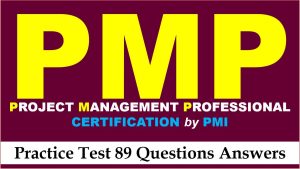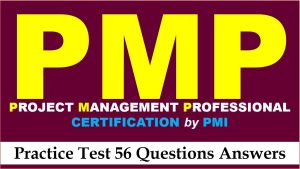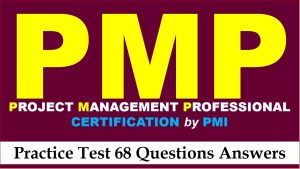Hi students, welcome to AKVTutorials. Are you getting ready for the PMP Exam? Do you find it difficult to remember PMP formulas? Therefore, you want to think about All PMP Exam Cheat Sheet Math Formulas PDF to get ready for the exam. To put oneself on the correct path, you must have formulas to memorize for PMP Exam. The arithmetic computations are one aspect that some PMP candidates find challenging. since learning a lot of PMP formulas is necessary. Cheat sheets for the PMP certification test and PMP formulas can make it easier for you to memories these. Additionally, you need to memories a few Frequently Used Concepts for the PMP certification exam. Thus, mastering PMP formulae the simple method would be particularly beneficial for your PMP journey.
At Last, URL to get PDF of this PMP Exam Cheat Sheet
PMP Exam Formulas Cheat Sheet
PMP Formulas Cheat Sheet: Integration Management
Present Value (PV) Formula:
where FV = Future Value, R = Rate of Interest Per year, n = Number of Years
Payback Period (PP) Formula:
where the length of time it takes the company to get back the initial cost of producing a product / services. Shorter the Payback Period is better the project.
Net Present Value (NPV) Formula:
where higher NPV is better.
Internal Rate of Return (IRR) Formula:
where IRR is bigger the better.
Benefit Cost Ratio (BCR) Formula:
where BCR is the cost benefit analysis. BCR is bigger the better. If BCR < 1, then project is rejected. and if BCR > 1, then project is accepted.
Return on Invested Capital (ROIC) Formula:
where ROIC is bigger the better.
Economic Value Add Benefit (EVA) Formula:
where Cost of Capital = Revenue – Op Exp – Taxes. EVA is bigger the better.
Opportunity Cost (OC) Formula:
where OC is smaller the better.
Working Capital (WC) Formula:
where WC is bigger the better.
Return on Sale (ROS) Formula:
where ROS is bigger the better.
Return on Assets (ROA) Formula:
where ROA is bigger the better.
Return on Investment (ROI) Formula:
where ROI is bigger the better.
Discounted Cash Flow (DCF) Formula:
where DCF is bigger the better.
PMP Exam Formulas Study Guide PDF: Schedule Management
Expected Activity Duration (EAD) Formula (Triangular Distribution):
where P = Pessimistic, M = Most Likely, O = Optimistic
Expected Activity Duration (EAD) Formula (Beta Distribution):
where P = Pessimistic, M = Most Likely, O = Optimistic
Standard Deviation (SD) Formula
where P = Pessimistic, O = Optimistic
Variance (Var) Formula
where P = Pessimistic, O = Optimistic
Total Float or Slack (TF or TS) Formula:
where ES = Early Start, EF = Early Finish, LS = Late Start, LF = Late Finish,
Activity Duration (AD) Formula:
where ES = Early Start, EF = Early Finish, LS = Late Start, LF = Late Finish,
PMP Certification Exam Formulas: Procurement Management
Sharing Ratio (SR) Formula:
where How cost saving or overrun will be shared, Y% = Buyer’s Share Ratio, and Z% = Seller’s Share Ratio
Targeted Price (TP) Formula:
where TC = Targeted Cost, TF = Targeted Fee
Final Price (FP) or Actual Fee (AF) Formula:
where AC = Actual Cost, TF = Targeted Fee, Z% = Seller’s Share Ratio
Saving Formula:
where TC = Targeted Cost, AC = Actual Cost
Bonus Formula:
where Z% = Seller’s Share Ratio
Contract Cost (CC) Formula:
where Z% = Seller’s Share Ratio
Total Cost (TC) Formula:
where CC = Contract Cost
PMP Exam Formula Guide: Communication Management
Number of Communication Channels Formula:
where N = Number of Project Members including Project Manager
PMP Exam Prep Formulas: Risk Management
Expected Monetary Value (EVM) Formula:
where EV = Earned Value, and AC = Actual Cost
PMP Exam Maths Formulas: Earned Value Management (EVM)
Budget At Completion (BAC) Formula:
where
Planned Value (PV) Formula:
where BAC = Budget At Completion
Actual Cost (AC) Formula:
where AC = Actual Cost
Earned Value (EV) Formula:
where BAC = Budget At Cost
Cost Variance (CV) Formula:
where EV = Earned Value, AC = Actual Cost
Cost Variance % (CV%) Formula:
where CV = Cost variance, EV = Earned Value
Schedule Variance (SV) Formula:
where EV = Earned variance, PV = Planned Value
Schedule Variance % (SV%) Formula:
where SV = Schedule variance, PV = Planned Value
Variance At Completion(VAC) Formula:
where BAC = Budget At Completion, EAC = Estimate At Completion
Cost Performing Index (CPI) Formula:
where EV = Earned Value, AC = Actual Cost, CPI = 1 means GOOD, CPI > 1 means Typical GOOD, CPI < 1 means BAD.
Schedule Performing Index (SPI) Formula:
where EV = Earned Value, PV = Planned Value, SPI = 1 means GOOD, SPI > 1 means Typical GOOD, SPI < 1 means BAD.
Estimate At Completion (EAC) Formula:
where AC = Actual Cost, BAC = Budget At Completion, EV = Earned Value, CPI = Cost Performing Index
Estimate To Complete (ETC) Formula:
where EAC = Earned At Cost, AC = Actual Cost



